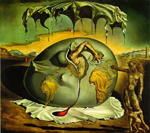
Betrayal
"Each subject appeared to enter his head, be ravaged, and thrown out" (617).
Flannery O'Connor's "The Lame Shall Enter First" (1965)
Points
for Reflection
EBB: "Bianca Among the Nightingales" (1862), 289-95
- do the figurative invocations of God and heaven by the narrator (ll.16-17) and Giulio (ll.21-22) successfully concretize and eternalize their love?
- why does the narrator twice observe that each man has but one soul (ll.39, 50)?
- why is the narrator currently in England instead of her native Italy?
- what exactly appears to have catalyzed Giulio’s shift in attention away from his Italian lover towards a new, English one?
- whom does the narrator blame more for her present circumstances, Giulio or his new lover?
- why does Barrett Browning close each stanza with “the nightingales”?
RB: "The Laboratory: Ancien Régime" (1844), 134-35
- why is it so important that the narrator and her auditor tie tightly the glass masks over their faces (ll.1-4)?
- what is the implied catalyst for the narrator's act of vengeance (ll.5-8)?
- to what alternative location might the narrator have retreated, and why (ll.6-8)?
- of the various ways poison might be delivered to its target, which of those envisioned by the narrator would be the most subtle (ll.15-21)?
- how many targets has the narrator chosen (ll.5-8, 21-24, 27-28)?
- why does the narrator think a single drop of poison too little to do the job right (ll.29-32), and yet not wish too much poison to be used (ll.36-40)?
- what do lines 33-34 and 44 reveal about the nature of the narrator's vengeful desire?
- what payment does the narrator provide her laboratory technician (ll.43-46)?
- what comprises the dust which the narrator wishes removed from her person (l.47)?
- what role does the narrator serve at court (ll.12, 48), and what does this suggest about her value to others?

Geopoliticus Child Watching the Birth of the New Man (1943)
oil on canvas
Salvador Dalí
Dr. Paul Marchbanks
pmarchba@calpoly.edu
![]()
